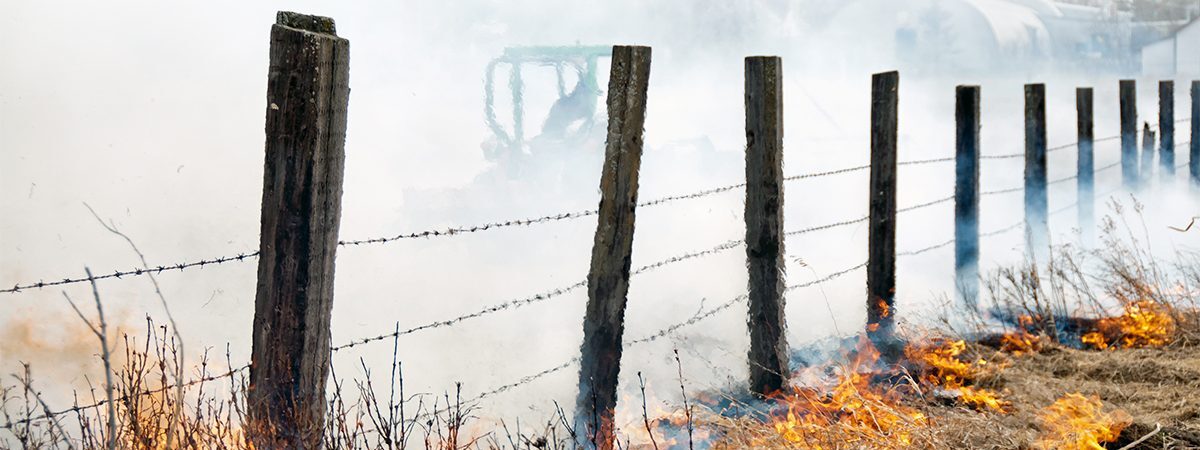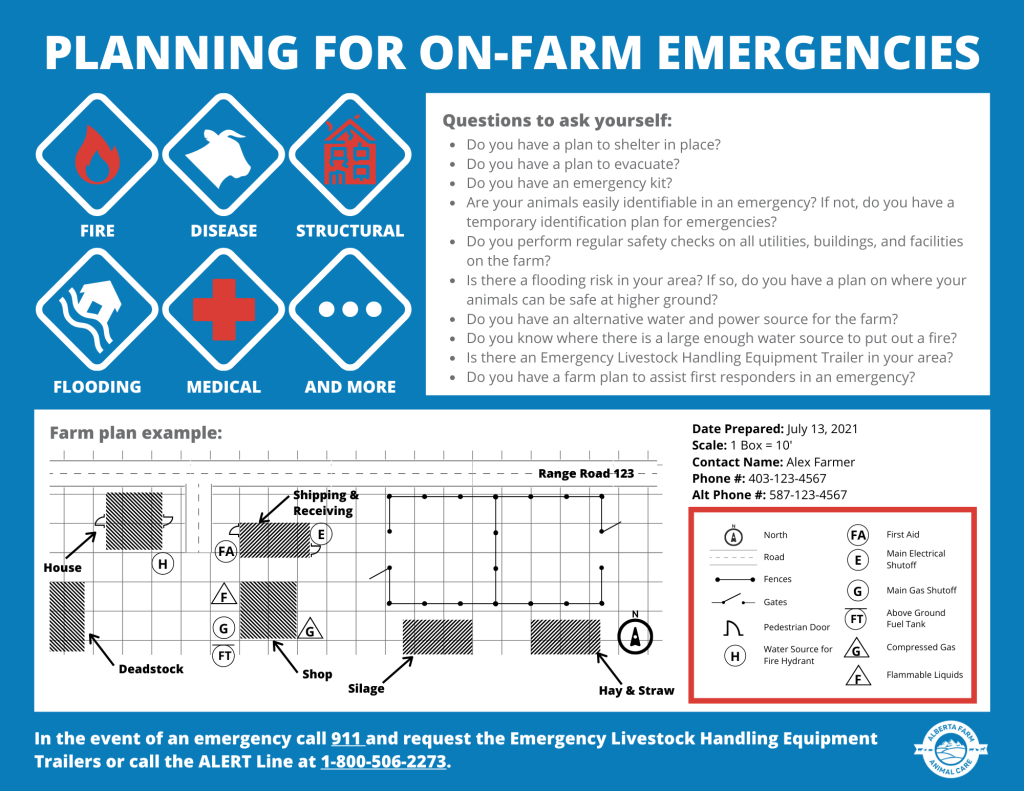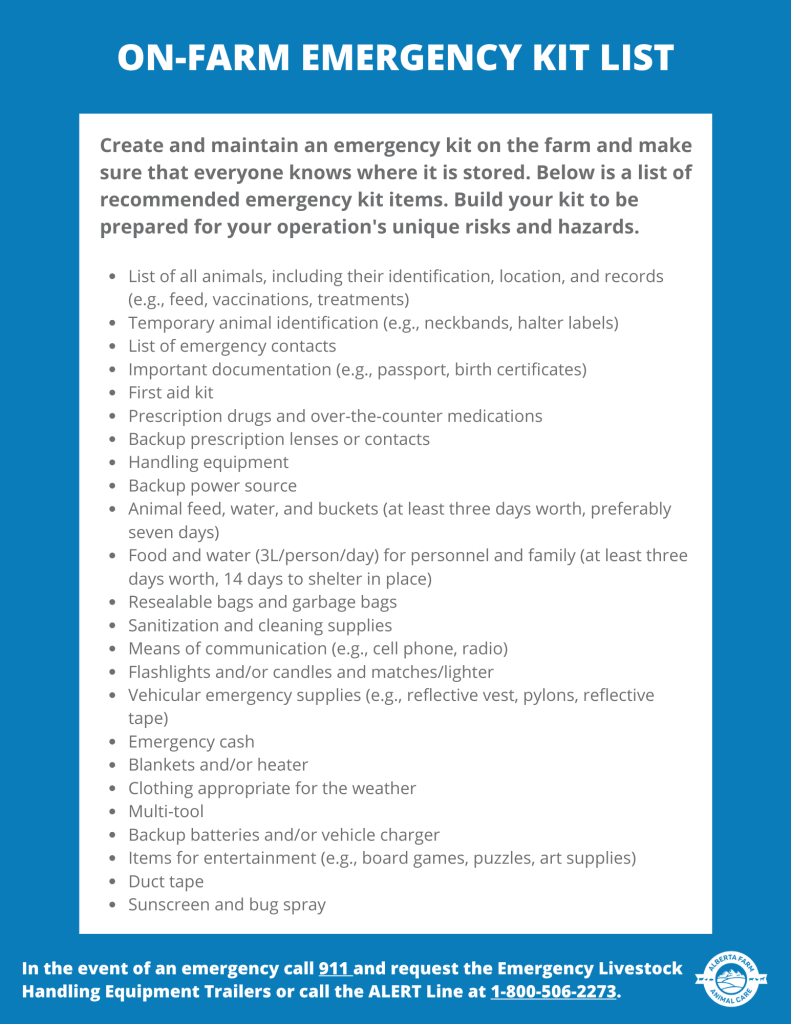AB Direct - Steers
Rail: 492.00-493.50 FOB feedlot (last week)
AB Direct - Heifers
Rail: 492.00-493.50 FOB feedlot (last week)
US Trade- Steers
Rail: 355.00-363.00 (IA, NE) last week
US Trade - Heifers
Rail: 355.00-363.00 (IA, NE) last week
Canadian Dollar
0.19

Be prepared for on-farm emergencies
Emergencies that involve livestock are complex and can progress quickly, putting people and animals at risk.
Natural disasters, such as fires and floods, can pose a severe threat to a farm. Farmers are familiar with what natural hazards exist in their area and should adjust their emergency plans accordingly. For example, a farm located in an area at risk of tornado formation should have a plan to shelter in place, and anything that could be blown around is secured during the tornado season.
Farms also come with their own laundry list of risks and hazards that could cause an emergency. Regular maintenance of fire suppression and emergency alert systems is vital to preventing and responding to an emergency. An expensive fire suppression system that is not maintained is worthless and could cost you more in the long run.

Fires can be prevented by regularly checking and addressing fire hazards. It can become easy to forget about that fan in the corner that has not been touched for five years and is covered in dust, but you will not forget the fire’s cause. Farmers must also plan out where the water to put out the fire will come from. The average fire truck holds about 500 gallons of water; enough to put out a trash can fire.
In the event of an emergency, farmers must make the difficult decision of whether they should shelter in place or evacuate. If an emergency event is approaching, such as a fire, this decision must be made well in advance to appropriately plan for everyone’s safety, including the animals. Do not wait for the authorities to tell you what to do. Like Alberta Emergency Alert, mobile alert programs are great resources to keep residents aware of emergency events in their area.
Producer Handbook: Preparing the Alberta beef sector for disease-related sector-wide emergencies
If the decision is to shelter in place, then the farm must have enough food and supplies to last for at least 72 hours for everyone that remains. However, enough supplies for up to 14 days is recommended. Farms are often in rural areas where help can take longer to arrive, so it is better to be overprepared than underprepared. Due to the unpredictable nature of emergencies, all farms should have an emergency kit that is kept stocked and prepared for seasonal risks (e.g., more blankets in the winter and bug spray in the summer).
During a shelter in place, the farmer must decide if the large animals should be placed in a shelter or left outside. The animals should be moved to the safest location available for that emergency. For example, in a flood, animals would be safest on higher ground, while in a hurricane, the animals may be better off inside, safe from flying debris. A safe pasture has the following characteristics:
- Native trees only – Invasive species are more likely to become uprooted.
- No power lines or poles – These can fall, causing injury and creating a fire risk.
- No debris – Debris can be blown around in a high wind event and cause injury.
- No barbed wire fencing – Woven wire is recommended.
- Plenty of space – At least one acre is recommended to give the animals room to flee.
If the decision is made to evacuate, all personnel and family members must be familiar with the evacuation plans. This ensures that everyone knows what must be done, who is in charge, and where they can go for safety. Before leaving the farm, contact the local emergency authorities and confirm at least two evacuation routes. Roads may become blocked during an emergency, and the goal is to evacuate effectively and safely.

Farmers cannot always evacuate with their animals. There may be too many animals to coordinate their transportation, or conditions make transport dangerous. If a farm must be evacuated, but the animals remain, then the farmer must pick the best location to shelter the animals, as described above. If animals can be evacuated to another site, such as a fairground, ensure they have identification and enough feed and water for at least 72 hours.
One of the best things a farmer can do to prepare for an emergency is to create a farm plan (see example below). This can be a single piece of paper with an aerial view of that farm that identifies buildings, hazards, animals location(s), and critical features of the farm, such as fire hazards, first aid, and power shutoff. Creating a farm plan helps the farmer with their farm emergency planning process, but it is an invaluable tool to first responders. Many farmers have had the unfortunate experience of returning to their farm to see that responders caused damage to their property in their efforts to help. All of which may have been avoided if the responders knew the layout of the farm.
Finally, a farm’s emergency plan should involve building a relationship with the first responders in your area. Try inviting them to the farm for a tour to get a better understanding of the hazards present and help make the farm plan the best it can be.
For more information on emergency preparedness, visit Alberta Farm Animal Care.
This article was first published in the September 2021 edition of ABP Magazine. Watch for more digital content from the magazine on ABP Daily.



